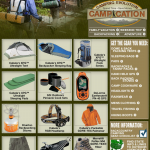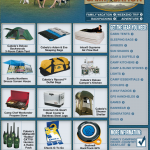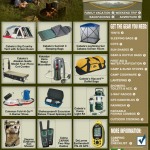Content Marketing Pitch to Large Outdoor Retailer
According to the Outdoor Industry Association, research shows that during economically difficult times, people budget by taking vacations closer to home.
“A renewed interest in economical, close-to-home vacations helped fuel sales of camping-related items in specialty stores this year. Sales of items such as tents (+2%), sleeping bags (+3%), camp stoves(+4%) , climbing gear (+3%), water purification (+11%), mattresses (+2%) and miscellaneous camp accessories (tent accessories +28%, sleeping bag accessories +7%, pack accessories +4%) all benefited, each outpacing 2007 dollar sales.” Outdoor Industry Association® WebNews, Feb. 17, 2009.
The Outdoor Industry Foundation coined this idea as “Staycations.” I propose Cabela’s create a web experience on cabelas.com named Stay-cations for presenting informational articles (how to/buyer’s guides, etc.), resource links and vacation ideas that customers can reasonably commit to within a few-hour radius from home.
The google meta description could read, “Families that vacation together stay together. Here’s a list of budget-friendly stay-cation ideas that promote family fun without the economic hardship.”
This them could extend into other hard-good categories including:
- Camping
- Winter sports (snowshoeing)
- Kayaking/canoeing
- Biking
“How-to” And Feature Article Ideas
The idea is to provide the customer with useful info, and in turn that will …
- reinforce the Cabela’s brand as an outdoor partner and expert
- present the audience with an ever-evolving, lively website that attracts return visitors
- promote the products that fit within each article/activity idea
- offer the right mix of products based on the customer’s needs (making for a better customer experience) rather than creating category pages based on merchant categories (the typical way of presenting categories today)
Informational Content
Feature and how-to articles will include printer-friendly PDFs of gear recommend for each activity (e.g. family camping, backcountry, family canoe trip, bike outings, etc.) that consumers can print out and have in hand as a resource when shopping at their local Cabela’s retailer.*
*(Note: this idea was proposed before the invention of equipment and checklist apps, notes and reminders).
The Stay-Cations landing page will include sidebars and/or thumbnails of products that link to their corresponding product offer display (POD) and related items. Informational linking can include hard goods, soft goods and proprietary products like Cabela’s-exclusive books, topographical and fishfinder GPS maps, guidebooks, etc.).
Article Ideas: How-To …
… rent a motor home for a weekend trip: Topics would include information on the rental process, how much you’ll save in comparison with traditional travel expenses like airfare and hotel costs, plus reference links to RV destinations and campsites.
… ride a ferry to an island (e.g. Madeline or Cumberland Island) for a family camping trip: Topics could extend into day trips while on the island, like a family kayak outing, or what equipment you’ll need to fish on the island.
… outfit yourself for an overnight canoe trip with a family of four: Information would include how to pack the gear necessary for two adults and two kids, food proportions for each family member for two days, lightweight freeze-dried food options and more.
… pack for a snowshoe outing: The article would cover typical snowshoe gear items required for this kind of outing, like backpacks, toe warmers, gloves, boots, snowpants, poles, etc. Topics could also cover what is hypothermia and how to layer clothing to thwart against hypothermia.
… get ready for a bicycle/camp outing: Article would include suggestions on how to pack lightly, info on bike navigation maps, and suggestions for lightweight camping essentials, like backpack stove, lightweight one-person tent and more.
Extending The Theme: Other Post Ideas
- Feature a new destination each week with information on fishing hot spots, campgrounds, canoe areas, scenic byways, bike paths, lakes to paddle, etc. For example, one week we could feature attractions in the Black Hills. Since the terrain is varied enough, we could save on research time by encompassing multiple outdoor categories within one city.
- Urban camping trip ideas that can be done on the cheap since it won’t include airfare and hotel costs. This could include RV parks or campsites near areas of interest, like historical monuments, theme parks, museums, etc. The topic could extend to urban canoeing destinations, urban biking destinations, etc.
- Family RV road trip ideas with links to destinations, gear list, etc.
- Kayak fishing destinations throughout the U.S.
Promotional Ideas
- Use the Outdoors Industry Retail Kit (note: original link no longer exists) to promote national parks in select retail stores. Host a movie screening of “The National Parks,” a film by Ken Burns. Invite a local expert to talk about area camping, paddling, bike paths, equipment needed, park trailhead information, etc.
- Coordinate with KOA campgrounds nearest to select Cabela’s retail stores and host a dry run family camping outing. Part I of the event could start at a Cabela’s retailer where retail outfitters could present product ideas for the camp outing. Part II of the event could include a dry run at a nearby KOA, so families can get a feel for the camping experience, but are close enough to revisit the Cabela’s retail store to purchase other required gear. It also gets the family familiar with their newly purchased gear—and the ability to ask the retailer questions if they don’t know how to use the gear.
- Create a U.S. map on cabelas.com with select KOA destinations and links that direct customers to the specified KOA home page. Cabela’s could collect a click-through percentage of reservation referrals.
Affiliate Links And Co-Op Ideas
The broad-stroke idea is to either develop a co-op marketing effort with the following organizations (or others like them), or create our own blog posts inspired by these types of topics:
FAMILY CAMPING DESTINANTION IDEAS












